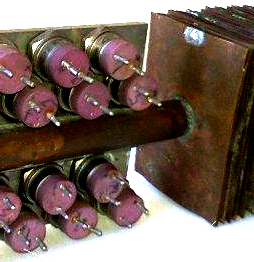Evaporation-condensation cooling systems for electronic equipment
DOI:
https://doi.org/10.3103/S0735272717070044Keywords:
thermal regimes of equipment, evaporation-condensation cooling systems, special types and designs, thermal characteristicsAbstract
The paper shows that heat pipes with metal-fibrous capillary structures and evaporation-condensation cooling system based on heat pipes are highly efficient means of providing optimal thermal conditions for different electronic instruments and devices. Such cooling system combining the functions of effective heating conduit (equivalent heat conductivity is much higher than the heat conductivity of the best heat-conducting materials) and effective radiator with the possibility of passive heat dissipation is characterized by a high heat transport ability, low thermal resistance, relatively small size and weight, reliable performance at different orientation in space under exposure to mass forces action. The paper presents examples of developed designs and investigations of heat pipes and evaporation-condensation systems with metal-fibrous capillary structures aimed at cooling the different heat generating items of electronic equipment. In this case, special types and designs of systems are discussed. These systems operate under different conditions of heat removal to absorbing medium and feature both a high heat transport ability and specific dielectric properties. In addition, the thermotechnical characteristics of proposed cooling systems are also presented.References
- SHMATOV, D.P. Simulation of hydrodynamic and heat-exchange processes in microchannel elements of cooling systems for electronic equipment. Abstract of Cand. Sci. Dissert. Voronezh: Voronezh State Techn. University, 2011.
- SUSHKO, V.Y. Thermal protection of electronic devices under intensive thermal exposure. Abstract of Cand. Sci. Dissert. St. Petersburg, St. Petersburg State University of Inform. Technologies, Mechanics and Optics, 2007.
- ERMOLAEV, I.A. Mathematical models and research techniques for convective fluxes of liquids and gases in cooling systems of electronic devices. Abstract of Doct. Sci. Dissert. Saratov: Yu. A. Gagarin Saratov State University, 2013.
- TSEVUKH, I.V.; SPIVAK, V.V.; MALYUTA, A.I.; SHUBA, T.N. Thermal management system for electronic devices. Tehnologiya i Konstruirovanie v Elektronnoi Apparature, n.1, p.20-22, 2016. DOI: http://doi.org/10.15222/TKEA2016.1.20.
- ISAKEEV, A.I.; KISELEV, I.G.; FILATOV, V.V. Effective Techniques for Cooling Power Semiconductor Devices [in Russian]. Leningrad: Energoizdat, 1982.
- DUL’NEV, G.N.; TARNOVSKII, N.N. Thermal Regimes of Electronic Equipment [in Russian]. Leningrad: Energiya, 1971.
- AKHIL, SOMAN; ANU, NAIR P. REMILBABU; SAMBATHKIRAN, P.K.; SUMESH, V.S. Study on natural convection heat transferIn an enclosure — A review. J. Mechanical Civil Engineering, v.13, n.4, p.26-30, 2016. DOI: http://doi.org/10.9790/1684-1304062630.
- POLUSHKIN, A.V. Impact of design parameters of conductive cooling system on the temperature regime of radioelectronic equipment in hermetic package. Abstract of Cand. Sci. Dissert. St. Petersburg: St. Petersburg State University of Inform. Technologies, Mechanics and Optics, 2007.
- GALLEFOSS, H. A device and a method for passive cooling of electronic equipment. Patent WO 2013056823 A1, IPC H05K 7/20 (2006/01), Publ. April 25, 2013.
- WEI, CHAO; LIU, ZHAO-JUN; LI, ZENG-YAO; QU, ZHI-GUO; HE, YA-LING; TAO, WEN-QUAN. Numerical study on some improvements in the passive cooling system of a radio base station base on multiscale thermal modeling methodology–Part I: confirmation of simplified models. Numerical Heat Transfer, Part A: Applications, v.65, n.9, p.844-862, 2014. DOI: http://dx.doi.org/10.1080/10407782.2013.826082.
- SEMENA, M.G.; GERSHUNI, A.N.; ZARIPOV, V.K. Heat Pipes with Metal-Fibrous Capillary Structures [in Russian]. Kiev: Vyssh. Shkola, 1984.
- CHEN, XIANPING; YE, HUAIYU; FAN, XUEJUN; REN, TIANLING; ZHANG, GUOQI. A review of small heat pipes for electronics. Applied Thermal Engineering, v.96, n.5, p.1-17, 2016. DOI: https://doi.org/10.1016/j.applthermaleng.2015.11.048.

Downloads
Published
2017-07-14
Issue
Section
Research Articles

